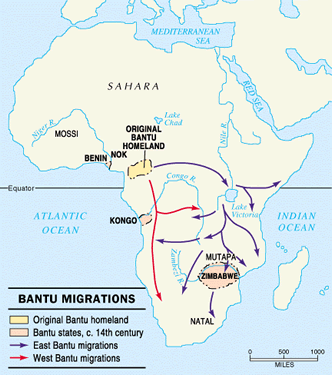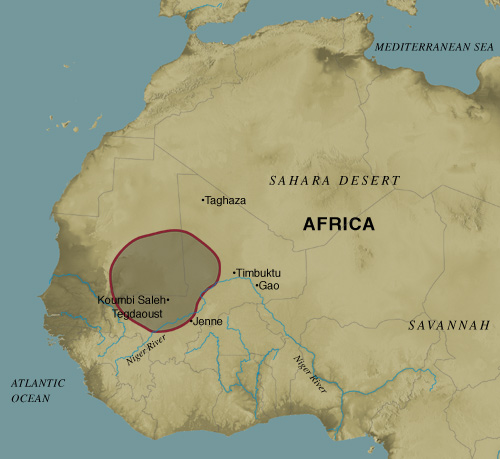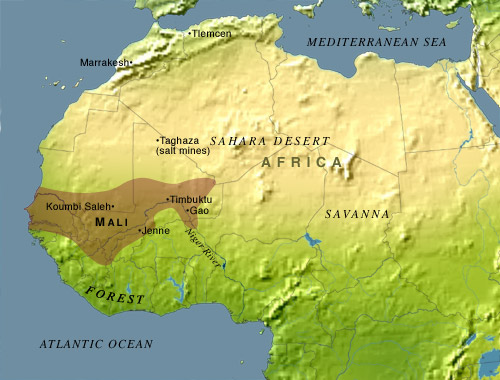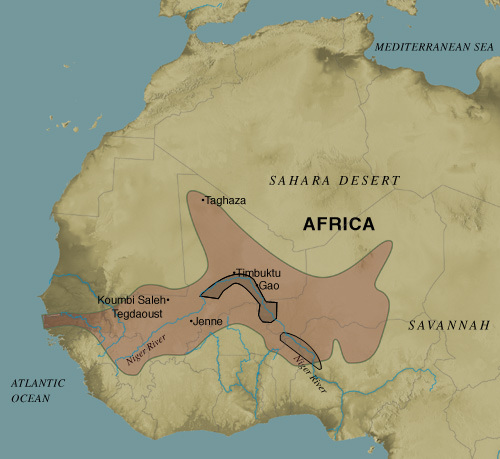|
The Bantu
Before the age of empires Sub-Saharan
Africa
was extremely
diversified. Unlike parts of
Europe
,
Asia
, and north
Africa, it was never united under a universal religion or empire/state.
Some
African societies were stateless, organized around kinship and family
obligation with no centralized authority.
Government in these societies was never a full time occupation;
there were no large armies, no large-scale political organization, no
large building projects, nor were there conditions to conduct
long-distant trade with other people.
What
similarities there were resulted from the earlier migration of the Bantu
people. Their root language
created common structure and vocabularies across African languages and
dialects; this allowed some mutual understanding among various tribes.
Most
African tribes also had similarities in their belief systems.
They were animistic, believing in a world controlled by spiritual
forces and gods. These
forces had to be dealt with through a specialist who would proscribe
rituals, sacrifices, or some other form of religious practice to affect
events. These beliefs
created a view of how the universe worked and how one should ethically
relate oneself to it. Their
dead ancestors, the first settlers of the land, were the true owners of
the land, and had a role in harvests and fertility.
Thus land was more than just a source of agriculture; it took on
religious significance.
As
far as the economies of
Africa
are concerned, the north was fully integrated
with the
Mediterranean
and Arab worlds of trade.
The Sub-Saharan was a completely different.
Its economies were primarily local and regional and varied so
much that it is impossible to generalize about them.
|

The Bantu migrations served to create a
linguistic basis for much of sub-Saharan Africa. Iron forging
technology and the introduction of bananas, a food source from southeast
Asia well suited to Africa's interior, are two important factors that
facilitated the migration of Bantu speaking people. |
The Christian
Kingdoms:
Nubia
and
Ethiopia
As
Islam spread across north Africa, there remained “islands” of
Christianity in the midst of its civilizations.
Christianity came to
Africa
before Islam.
Nubia
and
Ethiopia
(originally
known as
Axum
or
Aksum
) had had
Christian communities for several centuries before the Muslims came.
Originally tied to Byzantine Christianity, they eventually split
from them and developed their own unique Christian practices (known as
Coptic). When the Muslims
came, they tolerated the Coptic communities and gave them some limited
rights.
The
most important Christian community in
Africa
was
Ethiopia
.
Surrounded by Muslims and pagans, they took to the highland areas
and became self-sufficient. They
famously carved churches out of the mountain rock (see picture to the
right).
In the 16th century, the Ethiopian Christians were
threatened by a neighboring Muslim state.
The Portuguese arrived and drove the Muslims back and in return
attempted to convert the Ethiopians to Roman Catholicism.
This failed and
Ethiopia
remained an
isolated, Christian, and fiercely independent civilization.
|

Church of St. George in Ethiopia is carved from a single
rock. Ethiopian Christianity (Coptic) is an example of a form of
Christianity largely unaffected by Christian developments in Europe,
such as Roman Catholicism and Protestantism. |
|
The
Golden Age Empires: Ghana, Mali and Songhai
Ghana
The best known of the Iron Age states is
Ghana
(no direct connection or geographic overlap with the modern nation of Ghana
that gained its independence from Britain
in 1957.
Trans-Saharan trade was revolutionized between the
3rd-5th centuries when the Berber people
introduced the camel to the region.
The traders from the Ghana
area formed the link between the important resources of salt from the
northern part of
Africa
, and the gold from the sub-Saharan region. This connection integrated
them into the Mediterranean world and its trade connections with the
other (now weakening) classical civilizations. Their
control of the trans-Saharan gold trade allowed them to fund a large
army and rise to empire status.
After the 7th century their trading
partners to the north were Muslims.
Islam was at first only tolerated but by the 11th
century it seems the Ghana
kings converted. However,
this did not lead to the wider acceptance of Islam by the population.
Kings seemed to have understood the economic benefits of
tolerating Islam since it put them on good terms with their trading
partners to the north.
The ruling kings of
Ghana
were from the Soninke family whose power depended on their claim that
the Soninke king personally had rights over all gold nuggets (as opposed
to gold dust). This became
an automatic form of taxation which helped them stay in power.
|

The Empire of Ghana (750-1036)
|

The Mali Empire (1235-1670)
| The Great Mosque at Jenné (to
the right) is a vivid reminder of the presence and
role of Islam in the Golden Age Empires. What does the
construction and appearance of this Mosque tell us about the role of
Islam in Sub-Saharan Africa? |

|
|
Mali
In the early 1200s the chief of the Malinke people
challenged the authority of the ruling Soninke family.
The king Sundiata triumphed over the Soninke people and
established the most legendary West African empire of all,
Mali
. The story of Sundiata, also
called the Lion Prince, is the most famous epic from
Africa
, forming a rich literary tradition in the same way that Homer did for the
Greeks and the legend of King Author did for the English. (A reference to
the epic of Sundiata can be found in the opening of chapter 19 in your
textbook.) This story forms a
good example for the syncretic nature of African religion: Sundiata is
described as a devout Muslim but is still concerned with pleasing the
traditional spirits as well.
The empire of
Mali
stretched for thousands of miles from the west Atlantic coast of
Africa
across the sub-Saharan savanna. The
empire was more developed and oversaw much more extensive agriculture than
Ghana
did.
It was ruled by kings called Mansas.
Ibn Battuta, a famous Muslim traveler, visited
Mali
’s capital in 1352, and described the rule of these Mansas thus:
The Negroes
possess some admirable qualities. They are seldom unjust and have a
greater abhorrence of injustice than other people. Their Mansa shows no
mercy to anyone least guilty of the act of injustice.
There is complete security in their country.
Neither traveler nor inhabitant has anything to fear from robbers
or men of violence.
The most famous Mansa of the empire of
Mali
was Mansa Musa. In 1324-1325 he made his famous
hajj (pilgrimage to
Mecca
) which became very famous for the display of
extravagance shown en route. He
took 100 camels just to carry gold which he gave out as gifts along the
way. He was served by 500
slaves. In
Cairo
(
Egypt
) he gave away so much gold that the resulting surplus
caused its devaluation there. This famous pilgrimage was significant for 2
reasons. First of all, it put
Mali
“on the map” of the medieval world.
Word of his wealth and extravagance spread quickly and brought
attention to
Mali
. Secondly,
it shows the more serious role of Islam in Sub-Saharan Africa.
This display of devotion certainly denotes a more serious attitude
toward Islam than the mere toleration shown by many of
Ghana
’s kings.
|
|
Songhai (This Empire falls under Unit III)
As the
Mali
kings eventually lost power in the late 14th and early 15
century, rule moved slightly east to the
kingdom
of
Songhai
along the
Niger River
. The founder of this new
empire was Sonni Ali, a self-proclaimed Muslim, although many
question his devotion to Islam and it appears that he exploited the
religion to centralize his own political power (think of the combined
roles of military, religious, and political authority taught by Islam). Ali
was a military conqueror whose success, in part, lie in his use of war
boats along the
Niger River
. The primary opposition to Sunni
Ali's rule were the Muslim scholars at Timbuktu (see below). Ali
ruthlessly persecuted them when they challenged his power.
The
Songhai
’s empire was finally destroyed in 1591 by invaders from
Morocco
. These troops brought with
them a new weapon that the Africans could not match: firearms.
Guns had arrived in
Africa
.
|

The Songhai Empire (1464-1591)
|
 Timbuktu
became an important trading and scholarly center in sub-Saharan
Africa
during the Mail and
Songhai
empires. It is located on the northern bend of the
Niger River
, the southern edge of the
Sahara
desert. Here is a first hand
account of
Timbuktu
by a Leo Africanus when he visited the city in the early 1500s.
Timbuktu
became an important trading and scholarly center in sub-Saharan
Africa
during the Mail and
Songhai
empires. It is located on the northern bend of the
Niger River
, the southern edge of the
Sahara
desert. Here is a first hand
account of
Timbuktu
by a Leo Africanus when he visited the city in the early 1500s.
There are many
shops of craftsmen and merchants, especially of those who weave cotton and
cloth. To this place merchants
bring cloth from
Europe
.
All the women of this area, except maidservants, go with their
faces covered and sell all necessary kinds of food.
The inhabitants of this area are very rich, so much so that the
king has married both of his daughters to two rich merchants.
The rich king has many articles of gold and keeps a magnificent and
well-furnished court. When he
travels anywhere he rides a camel that is lead by some of his noblemen.
He travels likewise when he goes into war, and his warriors ride
upon horses. Attending him he
always has 3000 horsemen and a great number of foot soldiers armed with
poisonous arrows. Here there are many doctors, judges, priests and other
educated men that are well maintained at the kings cost. Many manuscripts
and books can be bought here and are sold here for more money than any
other merchandise.
In its heyday, Timbuktu was an important trading hub
for two of Africa's most important items of commerce: salt and gold. The
wealth of the city is evident from the quotation above. But Timbuktu also
became an important city for Islamic scholarship. Its Mosque contained a
library and a university where scholars, theologians, and Muslim jurists
studied. Thus the most important trade in Timbuktu was in books.
|
Yes, it's a real place. Below is
an aerial view of Timbuktu today. As you can see, it is the
gateway connecting Sub-Saharan Africa to the Sahara Desert.
 |
|
|







